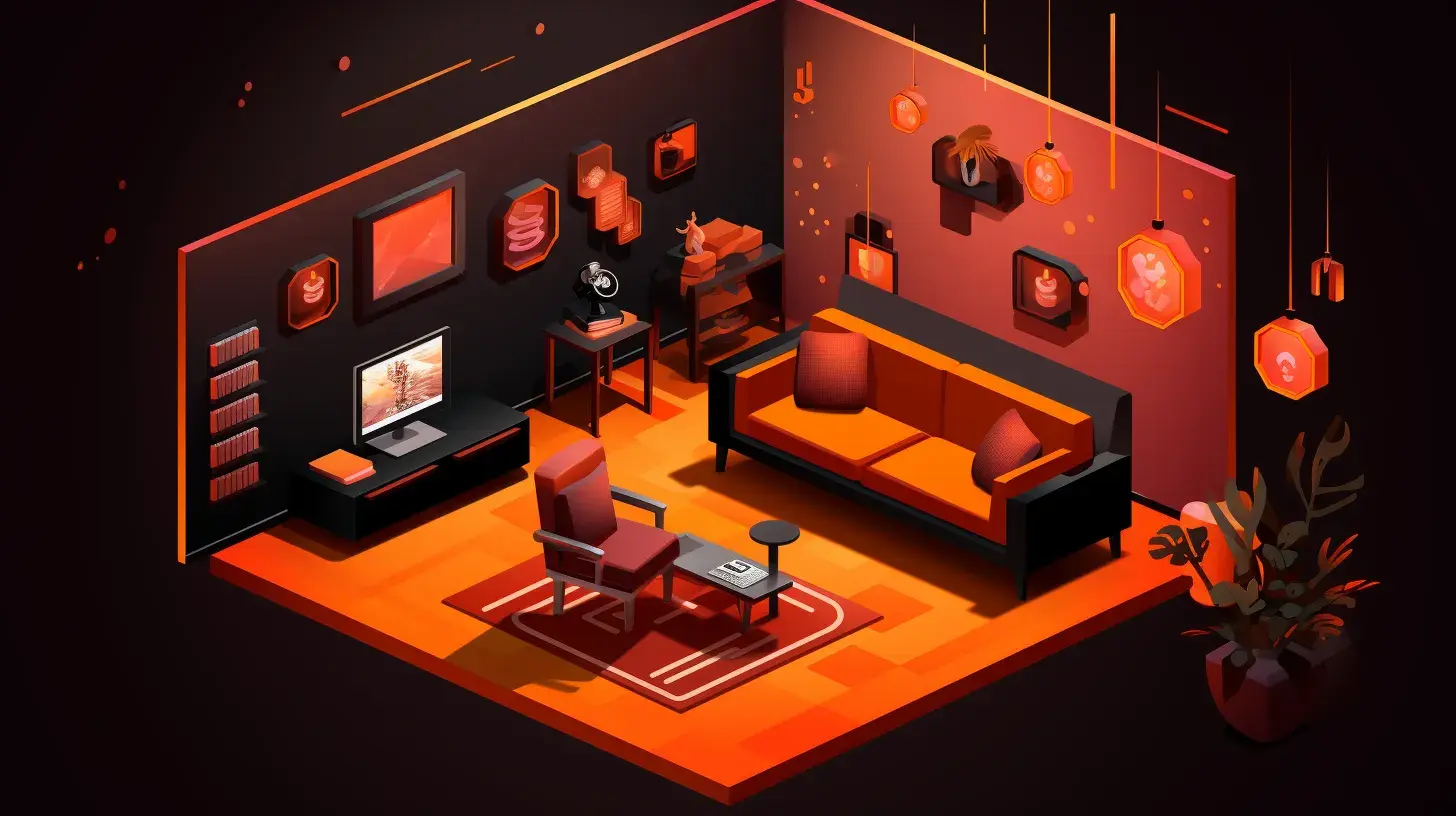A Guide To Metaverse Interior Design

Metaverse interior design is at the forefront of digital innovation, shaping how we experience virtual spaces. This dynamic field combines elements of metaverse design and VR interior design to craft captivating digital environments that seamlessly blend the physical and virtual worlds.
Join Metastack as we explore metaverse interior design, we will delve deep into its principles, applications, and the exciting future it holds.
What is Metaverse Interior Design
Metaverse interior design revolves around curating digital spaces where aesthetics, functionality, and user experience converge. It's about creating virtual environments that offer a sense of familiarity while pushing the boundaries of creativity within the metaverse.
The essence of metaverse interior design lies in its ability to bridge the gap between real and virtual realities. The primary objective is to make users feel comfortable and at ease in virtual spaces, much like in the physical world.
Imagine entering a metaverse-designed living room where the furniture, lighting, and ambiance evoke the same warmth and comfort as your home.
How Did Metaverse Interior Design Emerged
The emergence of metaverse interior design can be traced back to the evolution of virtual reality (VR), augmented reality (AR), and the broader concept of the metaverse itself.
Here's a chronological overview of how metaverse interior design emerged:
Early 3D environments (1980s-1990s)
Metaverse interior design finds its roots in developing VR and 3D graphics during this period, with industries like gaming and aerospace exploring immersive virtual environments.
Metaverse concept (Early 1990s-Present)
Coined by Neal Stephenson in "Snow Crash”, the metaverse concept evolved from fiction to a real-world vision of interconnected digital spaces.
Social VR and modern VR (2010s-Present)
The rise of VR headsets and social VR platforms like VRChat fueled the demand for well-designed virtual spaces.
Business and entertainment (2020s-Present)
Recognizing the metaverse's potential, industries integrated metaverse interior design for marketing, collaboration, and entertainment.
Diverse applications
Metaverse interior design spans gaming, education, retail, real estate, and social interaction, spurring specialization.
Specialized firms and education
Responding to demand, specialized firms and educational programs emerged to train designers for virtual environments.
AR integration
Metaverse interior design integrates with AR, blending physical and virtual spaces for more diverse experiences.
As the metaverse concept gains momentum, metaverse interior design will likely continue to evolve and play an increasingly important role in shaping our digital experiences.

The Principles of Metaverse Interior Design
Metaverse interior design is guided by principles that ensure the creation of aesthetically pleasing, functional, and user-friendly virtual spaces.
These principles are deeply rooted in the seamless integration of metaverse and VR interior design.
User-centered metaverse design
At the core of metaverse interior design is a user-centered approach. Designers prioritize understanding users' preferences, needs, and expectations to craft spaces that resonate with them.
Every design decision is made with the user's experience in mind, ensuring that virtual spaces are inviting and enjoyable.
Read: Immersive Design In The Metaverse
Immersion and realism in VR interiors
Immersion and realism are paramount in metaverse interior design. Designers meticulously replicate real-world elements within virtual spaces, from lifelike lighting and textures to spatial layouts that mimic physical environments.
This attention to detail enhances the sense of immersion, making users feel genuinely present in the metaverse.
Accessibility
Inclusivity is a fundamental principle of metaverse interior design. Designers prioritize creating virtual spaces that are accessible to users with varying abilities.
Navigability and usability are vital considerations, ensuring everyone can enjoy and engage with these digital environments.
Interactivity
Interactivity lies at the heart of metaverse interior design. Virtual spaces are designed to encourage user interaction with objects, other users, and the environment. This fosters engagement, making interactions within the metaverse more meaningful and enjoyable.
Read: Social Metaverse: How It Changes Human Interactions
Innovation
Metaverse interior design thrives on innovation. Designers constantly push the boundaries of what's possible, exploring new concepts, technologies, and aesthetics to create unique and memorable digital experiences.
This innovative spirit drives the evolution of metaverse and VR interior design.
Applications of Metaverse Interior Design
The versatility of metaverse interior design extends across various industries, offering a wide range of applications.
These applications highlight the profound impact of metaverse interior design on how we interact, learn, work, and socialize in the digital age.
Entertainment
Entertainment experiences are transformed by metaverse interior design. Virtual worlds, gaming environments, and immersive experiences benefit greatly from meticulously designed metaverse interiors.
Read: Virtual Reality Cinema: Storytelling And Cinematic Experiences In Metaverse
Education
Education embraces metaverse interior design to make learning engaging and interactive.
Virtual classrooms and educational spaces within the metaverse provide students with inspiring environments that stimulate curiosity and knowledge acquisition.
Business and collaboration
Virtual offices and meeting spaces are becoming increasingly popular, and metaverse interior design is pivotal in optimizing these spaces for productivity and enjoyment.
Collaborative environments within the metaverse foster effective teamwork, making remote work more engaging and efficient.
Read: The Intersection of Play and Meta Productivity in Virtual Spaces
Social interaction
Socializing in the metaverse is a growing trend, and metaverse interior design is instrumental in creating virtual clubs, art galleries, and social hubs that attract and retain users.
Retail and e-commerce
Brands are establishing their presence in the metaverse, offering virtual stores and showrooms that leverage metaverse interior design to influence consumer behavior.
These digital retail spaces enhance the shopping experience, driving sales and customer engagement.
Read: 5 Ways for Retailers to Use Their Metaverse Brands

Examples of Metaverse Interior Design
While there are many notable instances, here are a few famous cases that highlight the versatility and potential of metaverse interior design:
Decentraland's Art District
Decentraland's Art District is a dedicated zone within the virtual world where artists and creators have designed unique and immersive art installations and galleries.
These spaces often feature intricate metaverse interior design to complement the art on display, creating an environment that enhances the overall experience.
The Museum of Other Realities (MOR)
MOR is a virtual art museum designed to showcase immersive and interactive art experiences. The museum features striking architecture and well-thought-out exhibition spaces.
Artists worldwide contribute to MOR, and visitors can explore their creations, underscoring the metaverse's potential as an art platform.
Sinespace's Paris 1900
Sinespace, a virtual world platform, created "Paris 1900," an elaborately designed virtual recreation of early 20th-century Paris. The space authentically replicates the architecture, streets, and ambiance of the Belle Époque era.
It serves as an immersive historical experience within the metaverse, offering a glimpse into the past through meticulous metaverse interior design.
Read: The Renaissance Of Virtual Arts And Literature
Challenges in Metaverse Interior Design
Despite its promise, metaverse interior design presents unique challenges for designers to overcome. These challenges encompass technical constraints, rapid evolution, user adaptation, and ethical considerations.
Navigating technical constraints
Designers must work within the technical limitations of the metaverse platforms they are designing for. These constraints can impact the complexity of designs and the quality of visual elements, requiring creative solutions.
Staying ahead in a rapidly evolving field
The metaverse is evolving rapidly, and designers must remain on the edge of emerging technologies and trends. Adapting to these changes and staying ahead can be challenging but essential to delivering innovative designs.
Guiding users through adaptation
Users may face challenges in adapting to the conventions and interfaces of virtual spaces. Metaverse interior designers must prioritize creating intuitive and user-friendly environments to facilitate a seamless transition for users into the metaverse.
Addressing ethical considerations
As the metaverse becomes increasingly immersive, designers must grapple with ethical concerns about privacy, safety, and the potential for addictive experiences.
Striking a balance between innovation and responsibility is a crucial aspect of metaverse interior design.
Read: The Digital Divide: Ensuring Equal Access To The Metaverse
The Future of Metaverse Interior Design
Metaverse interior design is poised to become integral to our digital lives. As the metaverse continues to expand, we anticipate several developments that will shape the future of this field:
Specialized metaverse design firms
Design agencies and firms specializing in metaverse interior design will emerge, offering expertise in creating tailored virtual spaces for specific industries and user demographics.
Collaboration with architects
Architects will collaborate closely with metaverse interior designers to integrate physical and virtual spaces seamlessly, providing holistic solutions that redefine spatial design.
Education and training
Educational institutions will offer specialized programs and courses in metaverse interior design, equipping the next generation of designers with the skills and knowledge needed for this evolving field.
Read: Metaverse Training: The Future of Professional Upskilling
Augmented reality integration
Metaverse interior design will integrate with augmented reality (AR) to enhance real-world spaces and experiences. This integration will blur the lines between physical and virtual environments, opening up new possibilities for hybrid experiences.
Read: While The Future Is Metaverse, What's Now?

Final Thoughts
Metaverse interior design represents the convergence of creativity, technology, and human experience within the metaverse.
By embracing user-centered design, immersion, accessibility, interactivity, and innovation, metaverse interior designers are at the forefront of shaping our digital realities.
As the metaverse continues to expand and evolve, the role of metaverse interior designers will become increasingly pivotal, offering captivating and interconnected virtual experiences that enhance every facet of our lives.
Embrace the metaverse interior design revolution, where the possibilities are as limitless as the metaverse itself.
Keep up with Metastack to learn all about the Metaverse!



